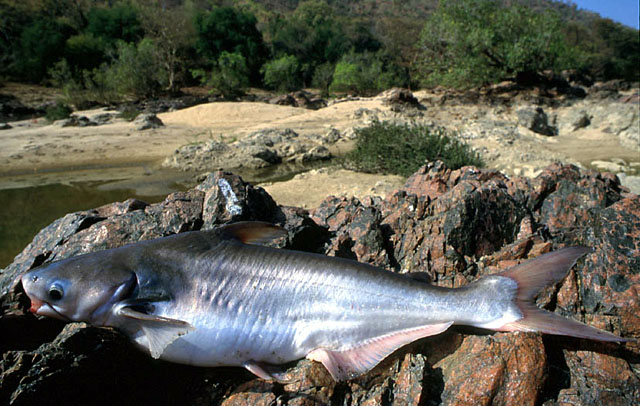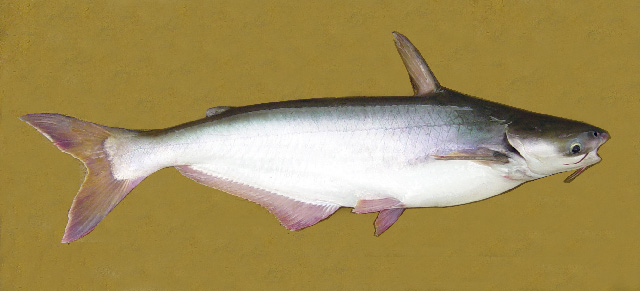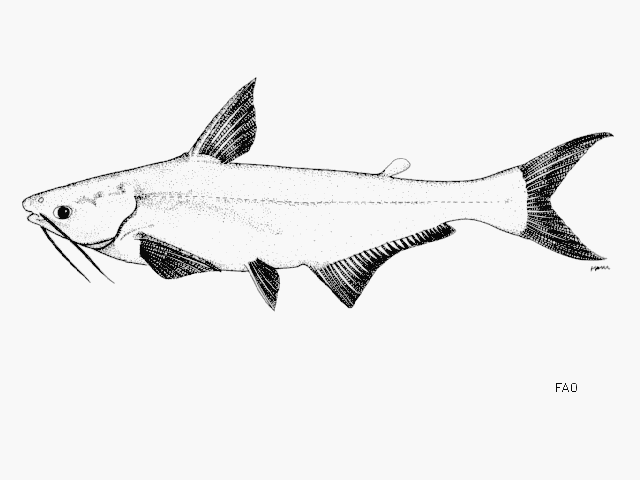Pangasius
pangasius
(Hamilton,
1822)
Pangas catfish
View all media / Upload your photos and videos
Expand all
Classification / Names
Teleostei (teleosts) > Siluriformes (Catfishes) >
Pangasiidae (Shark catfishes)
Etymology: Pangasius: The Vietnamese name of a fish (Ref. 45335).
More on author:
Hamilton.
Environment / milieu / depth range / climate zone / distribution range
Distribution
Asia: large rivers of Indian subcontinent and Myanmar (Ganges, Krishna?, Godavari, Irrawaddy). Widely introduced in its geographical range for aquaculture. Reports from Thailand, Malaysia and Indonesia are based on misidentifications.
Length at first maturity / Size / Weight / Age
Short description
Dorsal spines (total): 2; Dorsal soft rays (total): 7; Anal spines: 0; Anal soft rays: 29 - 32. Eye small, its diameter more than 7 times in head length (in 18 cm long specimens); bright yellow caudal fin in adults; maxillary barbel extends to gill aperture; 23-28 gill rakers on first arch (Ref. 12693).
Biology
Found in large rivers and estuaries (Ref. 4833). Occurs in high estuary (freshwater tidal zone) as juveniles, moving to brackish water as sub-adults, and finally as adults to river mouths and inshore areas (Ref. 12693). Longevity given as 10 years (Ref. 2686) but appears too low. Feeds on snails, other mollusks (Ref. 1479) and plants (Ref. 4833). Reared for consumption in Thailand, Cambodia and Vietnam; excellent food fish with very white fine grained sweet flesh (Ref. 2686). Marketed fresh (Ref. 12693).
Main reference
Roberts, T.R. and C. Vidthayanon 1991 Systematic revision of the Asian catfish family Pangasiidae, with biological observations and descriptions of three new species. Proc. Acad. Nat. Sci. Philad. 143:97-144. (Ref. 7432)
IUCN Red List Status (Ref. 125652)
Least Concern (LC); date assessed: October 13 2009
CITES (Ref. 131153)
Not Evaluated
CMS (Ref. 116361)
Not Evaluated
Threat to humans
Harmless
More information
- Countries
- FAO areas
- Ecosystems
- Occurrences
- Introductions
- Stocks
- Ecology
- Diet
- Food items
- Food consumption
- Ration
- Common names
- Synonyms
- Metabolism
- Predators
- Ecotoxicology
- Reproduction
- Maturity
- Spawning
- Spawning aggregation
- Fecundity
- Eggs
- Egg development
- Age/Size
- Growth
- Length-weight
- Length-length
- Length-frequencies
- Morphometrics
- Morphology
- Larvae
- Larval dynamics
- Recruitment
- Abundance
- References
- Aquaculture
- Aquaculture profile
- Strains
- Genetics
- Allele frequencies
- Heritability
- Diseases
- Processing
- Mass conversion
- Vision
- Pictures
- Stamps, Coins Misc.
- Sounds
- Ciguatera
- Speed
- Swim. type
- Gill area
- Otoliths
- Brains
Estimates based on models
Phylogenetic diversity index (Ref. 82804): PD50 = 0.5 [Uniqueness, from 0.5 = low to 2.0 = high].
Bayesian length-weight: a=0.00912 (0.00449 - 0.01852), b=2.98 (2.79 - 3.17), in cm total length, based on LWR estimates for this species & (Sub)family-body (Ref. 93245).
Trophic level (Ref. 69278): 3.4 ±0.5 se; Based on food items.
Resilience (Ref. 120179): Very low, minimum population doubling time more than 14 years (K=0.04; tmax=10(?)).
Fishing vulnerability (Ref. 59153): Very high vulnerability (90 of 100).
Price category (Ref. 80766): Unknown.
Nutrients (Ref. 124155): Calcium = 9.58 [5.32, 28.00] mg/100g; Iron = 0.355 [0.137, 0.964] mg/100g; Protein = 16 [15, 18] %; Omega3 = 0.194 [0.103, 0.381] g/100g; Selenium = 96.9 [51.0, 226.1] μg/100g; VitaminA = 9.49 [2.55, 35.16] μg/100g; Zinc = 1.58 [0.53, 2.65] mg/100g (wet weight); based on nutrient studies.



